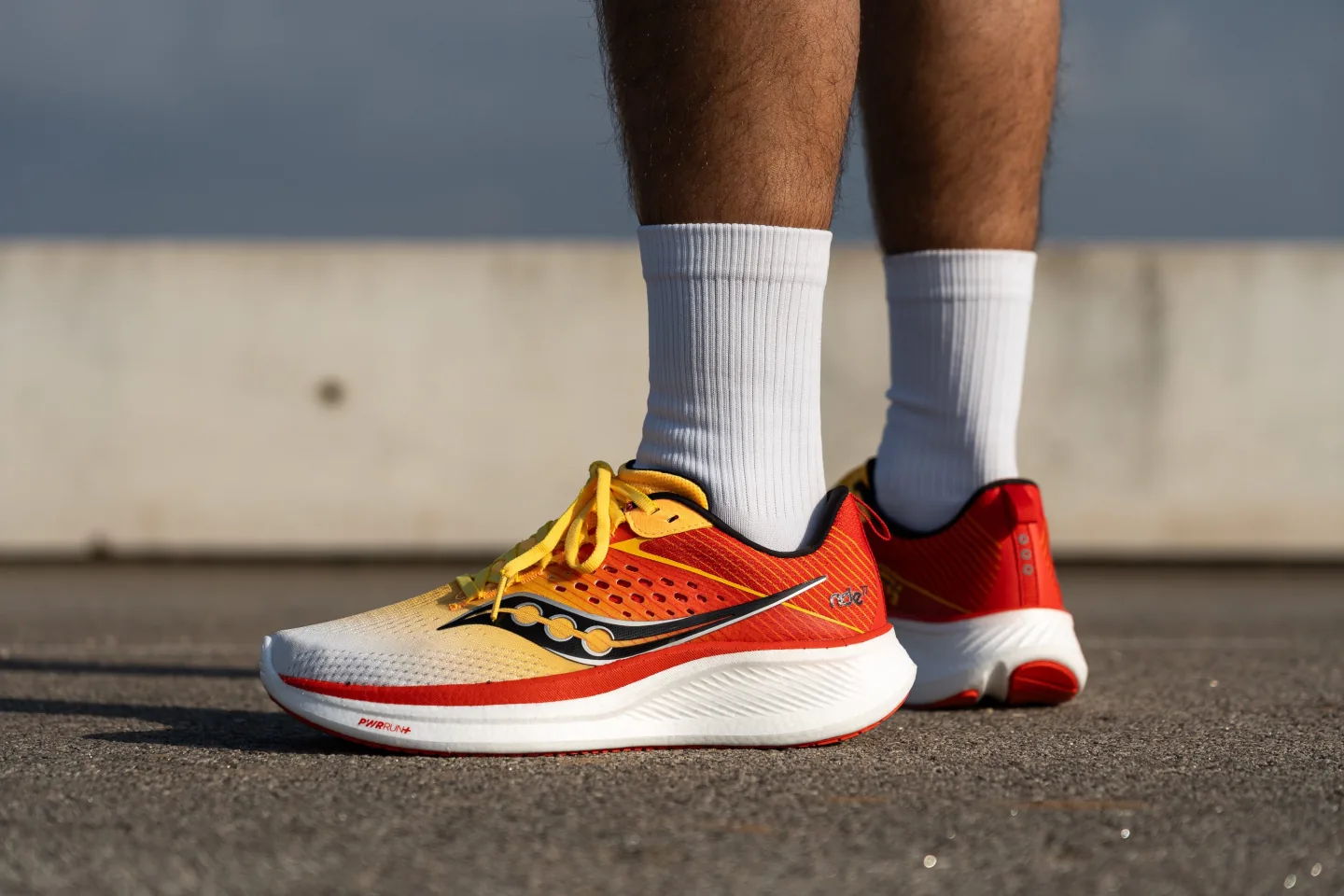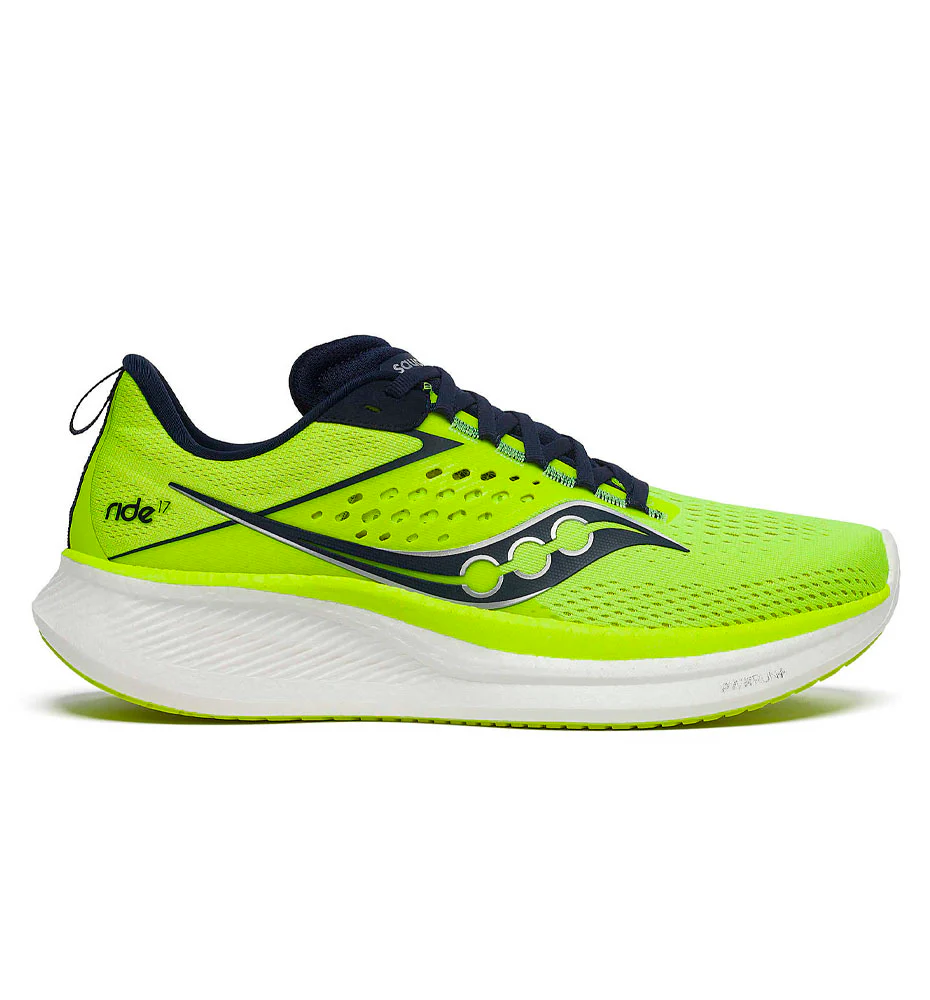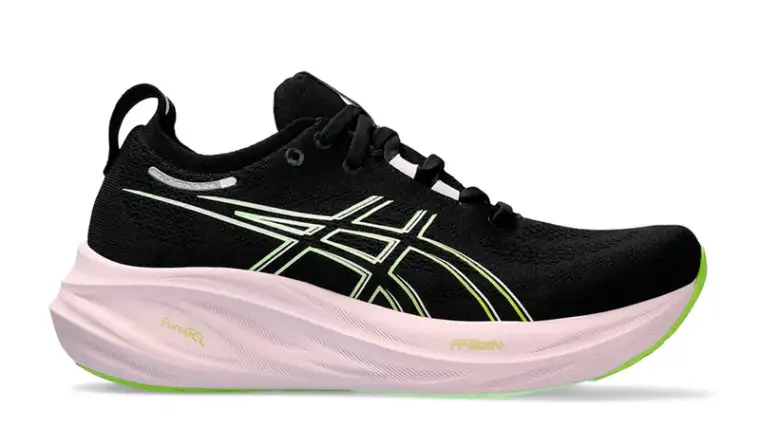The Saucony Ride 17 comes with major upgrades to this popular daily trainer series. The new PWRRUN+ foam makes the shoe softer and bouncier for runners. The shoe keeps its trusted 8mm drop that has been a standard throughout the series.
The Ride 17’s 35.1mm heel stack height stands 1.8mm taller than its predecessor. With a stack setup of 35/27mm, it gives runners a well-cushioned platform that works for many running styles. The shoe weighs slightly more now – 9.9 oz (282g) for men and 8.4 oz (238g) for women. This puts it in the mid-weight range, just above the 10-oz measure at 10.2 oz in some sizes. The engineered mesh upper has a high-volume fit that makes longer runs more comfortable.
This complete review will help you decide if the Saucony Ride 17 belongs in your running shoe collection. We’ll look at how it performs on different runs and assess its fit, comfort, and durability. We’ll also see how it stacks up against other models like the Triumph 22. The Triumph 22 uses similar technology but has a higher 10mm drop and different stack height of 37/27mm. This piece gives you all the details to pick the right Saucony shoe for your needs.

Table of Contents
Specs and Key Features of the Saucony Ride 17
The Saucony Ride 17 packs some impressive technical updates under the hood. Let’s get into the details that make this neutral daily trainer a versatile option for any runner.
Weight, drop, and stack height
The men’s Saucony Ride 17 weighs 9.9 oz (282g) in size 9, while the women’s comes in at 8.4 oz (238g) in size 7.5. These numbers show a slight increase from the Ride 16, which weighed around 8.8 oz in the same size.
Stack height numbers tell an interesting story. You’ll find a 35mm heel and 27mm forefoot, giving you an 8mm drop. This matches earlier Ride models’ geometry. The overall stack stands a bit taller than before, with a 35.1mm heel stack that’s 1.8mm higher than the Ride 16.
The Saucony Triumph 21 stacks up differently. It has 2mm more foam in the heel (37mm vs 35mm) with identical forefoot cushioning, which results in a 10mm drop instead of the Ride 17’s 8mm.
PWRRUN+ midsole upgrade
The most important improvement in the Ride 17 is its switch from PWRRUN to PWRRUN+ midsole foam. This TPU-based cushioning is a big step up from the EVA-based PWRRUN in older models.
The new PWRRUN+ midsole brings several advantages:
- 10% better energy return than previous versions
- A bouncier feel with more response
- Softer cushioning that doesn’t sacrifice responsiveness
The shoe also has a PWRRUN+ sockliner that makes it comfortable right out of the box. Lab tests show a durometer reading of 19.0 HA, that indicates balanced, moderately soft cushioning.
Upper material and breathability
The engineered mesh upper focuses on securing your midfoot and keeping your heel comfortable. Key features include:
- A flexible plastic midfoot wrap that locks your foot down comfortably
- Just enough padding in the collar and tongue
- A gusseted tongue with smart padding that balances comfort and performance
- A stretchy fit that keeps your foot secure while allowing natural movement
The upper has large ventilation holes, but lab tests tell a different story. The shoe scored only 2 out of 5 in breathability smoke tests. A comfort layer beneath the visible holes limits airflow more than expected.
Outsole design and traction
The Ride 17’s outsole uses more rubber than its predecessor. Carbon rubber covers high-wear spots, especially the heel and lateral side. This improves durability without making the shoe too heavy.
The outsole design includes deep cutouts and exposed foam through the midfoot and forefoot to keep weight reasonable. You’ll get good grip on wet roads, and the shoe really shines on softer surfaces like packed gravel or sandy paths.
Available sizes and fit options
Most runners find the Saucony Ride 17 fits true to size. The fit features:
- A comfortable regular width for average feet
- More forefoot room than the Ride 16 for better toe spread
- A secure fit through the midfoot and heel
- Wide width options if you need extra space
The toe box measures 96.9mm across—slightly wider than average. The front narrows more than usual, which might not work well if you have particularly wide feet.

How the Ride 17 Performs on Different Runs
The Saucony Ride 17 delivers a distinctly different experience than its predecessor right from the first stride. The major upgrade to PWRRUN+ foam gives this versatile daily trainer unique performance features for runners of all types.
Daily training and recovery runs
The Ride 17 shines as an everyday workhorse. Testers found the shoe needed a quick break-in period and felt firmer than expected despite its soft feel while walking. The Ride 17 becomes your perfect partner for those daily miles where comfort matters more than speed.
“The shoe disappears underfoot, and I don’t even think about what shoe I’m wearing,” said a tester who used it for runs between 3-10 miles. This disappearing act makes it perfect for maintenance runs where enjoying the run matters more than pace.
Some runners thought the Ride 17 felt slightly “clunky” during recovery runs because of resistance during the transition from original contact to push-off. The extra weight compared to the previous version (about 1 oz heavier) might cause this feeling, though many runners found it worked well for easy recovery sessions after hard training blocks.
Long-distance comfort and support
The Ride 17 proves its worth on longer runs. A dedicated tester finished a 50K on pavement and reported their “feet felt great” throughout the tough distance. The PWRRUN+ midsole absorbs impact effectively on contact, which makes downhill sections fun as runners can pick up speed without beating up their quads or knees.
Testers agreed the Ride 17 gives excellent protection for longer efforts, with an experienced runner noting it was “great for long runs”. The protective cushioning maintains comfort as miles add up, even with the added weight.
Responsiveness during tempo efforts
The Ride 17 shows remarkable versatility as pace increases. Several testers confirmed the shoe “comes alive at higher paces” and delivers more energy return under pressure. The forefoot transition and midsole bounce make this shoe work well for moderate and uptempo paces.
A tester completed 30 minutes at tempo pace (averaging 6:50 per mile) during a 12-mile run on tough gravel terrain with 100ft elevation gain per mile. Another runner lost track of pace during their treadmill workout because of the “rocker-like foot roll” they experienced in the Ride 17.
The Ride 17 can “sub in for a speed workout in a pinch”, offering enough snap for most runners’ tempo sessions, though it’s not primarily designed as a speed shoe.
Stability for heel and midfoot strikers
The Ride 17 delivers outstanding stability for a neutral trainer. The wide, flared-out midsole creates a secure platform that helps both heel and midfoot strikers. Lab tests showed a remarkable 125.1mm forefoot width—numbers usually seen in stability-focused shoes.
Midfoot strikers love how the wide base and sole flare in the forefoot create smooth landings. Heel strikers benefit from the beveled heel and transition groove that splits the crash pad for smoother original contact.
Sidewalls on both lateral and medial sides boost stability and create a secure feeling throughout the gait cycle without needing traditional stability features. This design keeps the Ride 17 stable despite its softer cushioning, making it available to runners with different styles.
Fit and Comfort: What to Expect
The Saucony Ride 17’s fit profile shows how much thought went into runner comfort. This daily trainer balances security and comfort perfectly. It works well for different foot shapes and running styles.
True to size or not?
The Saucony Ride 17 fits true to size based on multiple test results. Testers agree on this point, which shows Saucony got the sizing right. Both men’s and women’s models stay consistent, and one tester mentioned having “a full thumb’s width from the front of their big toe to the end of the shoe”.
Runners took these shoes straight from the box to 22km runs without any sizing problems. The Ride 17 gives you more room inside than the Ride 16, but you won’t need to size down. Saucony’s standard width works well for most runners, though wide options are available.
Toe box width and height
The toe box measurements tell an interesting story. The 96.9mm forefoot width beats the average, but the front narrows more than usual. Runners with wider feet might feel squeezed by this pointed shape.
The height makes up for any width concerns. At 29.1mm, the toe box rises higher than most rivals. A molded bumper creates this high ceiling design that lets toes move freely. Many runners found enough space to spread their toes on long runs, even with the narrower front.
Heel lockdown and tongue padding
The heel combines moderate padding with a firm lower counter that softens near the top. Most runners get a secure fit without needing a runner’s knot.
The tongue stands out with 9.0mm of padding—way thicker than most shoes. This plush cushioning stops lace bite no matter how tight you tie them. A gusseted design keeps the tongue in place while running, though one reviewer wished for a tongue loop to prevent slight side movement.
Insole and arch support
The Ride 17 has a removable PWRRUN+ sockliner that adds serious comfort. This thick insole puts soft cushioning right under your feet, making it feel more luxurious than shoes without this feature.
The shoe’s higher sidewalls cradle your foot better than older models did. One tester with high arches who overpronates found that the shoe adapted to their foot shape after a few runs, giving unexpected support.
Durability and Build Quality
Runners want to know if the Saucony Ride 17 can handle hundreds of training miles beyond its technical specs. Our tests show this model has amazing durability in all its parts.
Outsole wear resistance
Saucony placed rubber in high-wear areas of the Ride 17 to improve overall durability. The outsole now has more carbon rubber in the heel and lateral side than older versions. Tests reveal great resilience – reviewers found barely any visible wear on the outsole after 60 miles. Lab tests showed exceptional results. The Dremel tool only removed 0.3mm of material, way better than the 1.0mm average. The outsole is 3.4mm thick, so runners can expect 400-500 miles from these shoes.
Upper mesh durability
The engineered mesh upper stays strong despite early worries about its outer layer. The toebox scored 3/5 in durability tests, matching other shoes. The heel padding area did great with a 4/5 score in durability tests – this is a big deal as it means that it beat the 3.3 average. Reviewers found little change between the Ride 16 and 17’s upper, and both kept feet locked in place.
Midsole performance over time
The PWRRUN+ TPU-based midsole lasts longer than regular EVA foams. This advanced material keeps its bounce and cushioning better than standard options. The trade-off for this better durability adds about an ounce to the shoe’s weight. Experienced testers found steady performance even after lots of miles, with one runner seeing no wear after 30 miles.
Cold weather performance
The TPU-based PWRRUN+ foam works great in cold weather. Lab tests show the midsole gets only 20.4% stiffer in cold temps – much better than the 25% industry average. Year-round consistency sets it apart from EVA foams that get too firm in winter. Runners who train outdoors all year will get reliable performance whatever the temperature.
How It Compares: Saucony Ride vs Triumph and Others
Looking at Saucony’s shoe lineup reveals some key differences that help runners pick the right shoe. The Ride 17 stands out uniquely in the brand’s collection.
Saucony Ride 17 vs Saucony Triumph 22
The Ride 17 and Triumph 22 come with completely different midsole materials. The Ride 17 uses PWRRUN+ (TPU-based) foam, while the Triumph 22 packs PWRRUN PB, Saucony’s premium PEBA-based superfoam. The Triumph 22 has a higher heel-to-toe offset (10mm vs the Ride 17’s 8mm) and a bit more stack height (37/27mm vs 35/27mm). The Triumph gives you more cushioning, and the Ride 17 feels a touch softer with better flexibility. You’ll pay about USD 20.00 more for the Triumph 22 than the Ride 17.
Ride 17 vs Ride 15 and 16
The Ride 17 breaks new ground compared to earlier versions. The switch from EVA-based PWRRUN foam to PWRRUN+ creates a softer, bouncier feel unlike the flatter ride of models 15 and 16. The Ride 17 weighs more—a full ounce in women’s size 8—but gives you better cushioning. The Ride 17’s forefoot offers extra space compared to the tighter fit of Ride 15 and 16. Runners who want a shoe for easy runs will love the Ride 17’s cushioning and comfort.
Ride 17 vs Saucony Guide
These models got updates together but serve different needs. The Guide 17 tackles stability with CENTERPATH technology that includes wider flared platforms, raised sidewalls, and an asymmetrical profile. The Guide skips traditional medial posts for firm sidewalls around the foot. The Ride 17 stays neutral with PWRRUN+ foam, unlike the Guide’s softer PWRRUN. Heel strikers might prefer the Ride’s 8mm drop over the Guide’s 6mm.
Is it worth upgrading?
Most runners will say yes. The Ride 17’s PWRRUN+ midsole makes a real difference in comfort and responsiveness. Runners who like lightweight shoes with firmer rides might stick with the Ride 16. Triumph 21 users looking for something a bit firmer could love the Ride 17, especially since it costs USD 30.00 less.
Summing all up
The Saucony Ride 17 is more than just a minor update – it’s a complete transformation of the Ride series. PWRRUN+ foam revolutionizes the running experience with better energy return and a bouncier feel than earlier versions. The biggest drawback is the extra weight, which adds about an ounce to both men’s and women’s models. But this trade-off brings much better cushioning, comfort, and cold-weather performance.
This shoe’s versatility really shines through. The Ride 17 handles daily training miles with ease and shows surprising zip during tempo runs. It also provides great protection when you’re going the distance. The shoe fits true to size, locks down your heel securely, and gives your toes plenty of room to move. On top of that, it delivers great stability for a neutral trainer thanks to its wide base and smart sidewall design.
The shoe’s durability is a major plus. Carbon rubber placed in key spots and the TPU-based midsole’s resistance to compression mean these shoes should keep performing well past 400 miles. The midsole stays consistent in cold weather too, making the Ride 17 a reliable partner all year round.
To name just one example, see how runners choose between Saucony models based on their needs. The Triumph 22 might work better if you want maximum cushioning, while the Guide 17 suits runners who need more stability. In spite of that, the Ride 17 finds that sweet spot of comfort, versatility, and value most everyday runners want.
Your perfect running shoe depends on your priorities and running style. The Saucony Ride 17 is a great choice if you need a dependable daily trainer that can handle everything from easy recovery jogs to long runs. The improved cushioning, durability, and all-around performance make this update worth the investment, even with the slight weight increase.
Here are some FAQs about the Saucony Ride 17:
Is Saucony Ride 17 for long runs?
The saucony ride 17 is an excellent choice for long runs, offering balanced cushioning and responsiveness that performs well at distance. According to saucony ride 17 review feedback, the PWRRUN cushioning provides lasting comfort that holds up through extended mileage. Both the saucony ride 17 women’s and men’s versions deliver the durability and energy return needed for comfortable long-distance training sessions.
When did Saucony Guide 17 come out?
The Saucony Guide 17 (a different stability-focused model from the ride 17 saucony) was released in early 2024. This launch came slightly after the saucony ride 17, which debuted in late 2023 as part of Saucony’s neutral running shoe lineup. The ride 17 saucony and Guide 17 represent parallel updates to their respective product families.
Is Saucony Ride 17 a stability shoe?
No, the saucony ride 17 mens and women’s models are neutral running shoes designed without added stability features. Unlike Saucony’s Guide series, the saucony ride 17 review analyses confirm it’s built for runners who don’t need pronation control. The ride 17 saucony focuses on delivering a smooth, cushioned ride for neutral gaits.
When did Saucony Ride 18 come out?
The Saucony Ride 18 is expected to launch in late 2024 or early 2025 as the successor to the current saucony ride 17. Based on typical product cycles, the ride 17 saucony will remain available until the newer version hits the market. The saucony ride 17 review community will likely compare it to the 18 once released.
Can you run a marathon in Saucony ride?
Yes, many runners successfully complete marathons in the saucony ride 17, thanks to its reliable cushioning and durability. The saucony ride 17 women’s and men’s versions provide sufficient protection for 26.2 miles while remaining lightweight enough for race day. According to saucony ride 17 review feedback, it’s a popular choice among runners who prefer a balanced trainer over a maximalist shoe for marathons.
What is the upgrade to the Saucony Ride 17?
The saucony ride 17 improved upon its predecessor with a redesigned PWRRUN midsole and more breathable upper construction. Key upgrades noted in saucony ride 17 review articles include enhanced energy return and a more accommodating toe box in both the ride 17 saucony men’s and women’s models. The outsole also features updated rubber placement for improved durability.
How often should I replace running shoes?
Most running shoes, including the saucony ride 17, typically last 300-500 miles depending on your running style and body weight. The saucony ride 17 review community suggests monitoring midsole compression and outsole wear as indicators for replacement. Both the saucony ride 17 women’s and men’s versions will show visible wear patterns when it’s time for a new pair.


